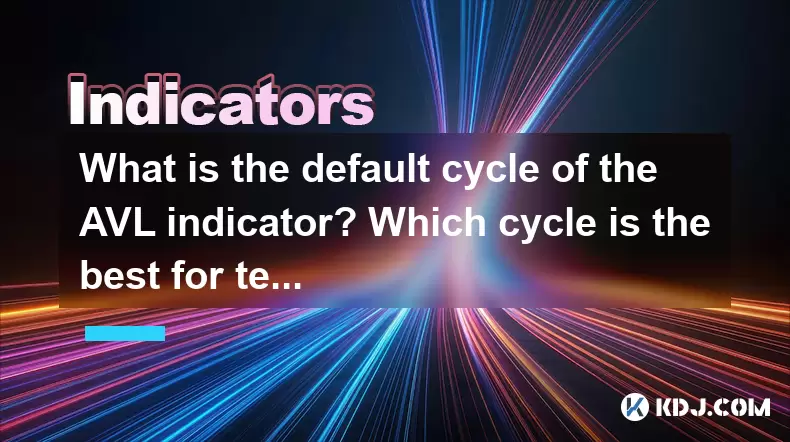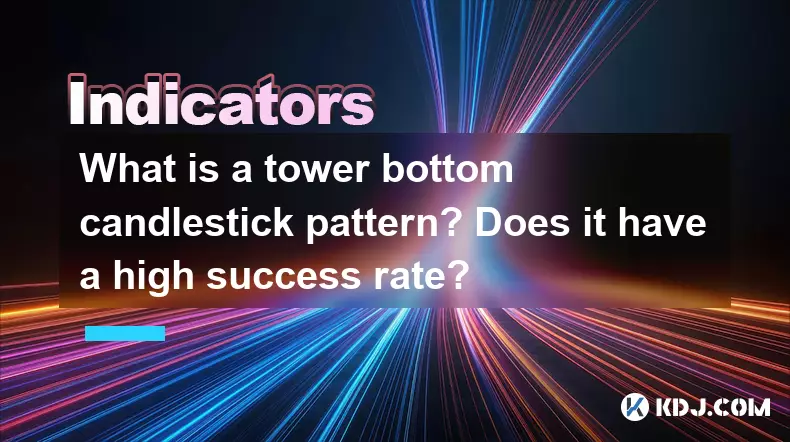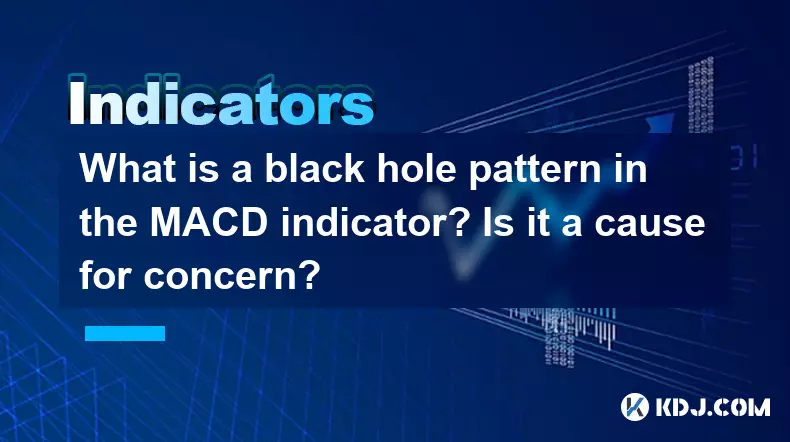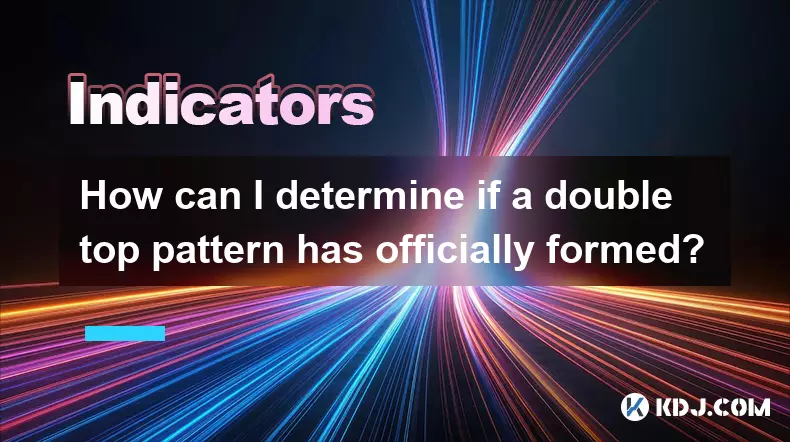-
 bitcoin
bitcoin $114320.977035 USD
-0.40% -
 ethereum
ethereum $4152.439985 USD
-1.75% -
 tether
tether $1.000111 USD
-0.04% -
 xrp
xrp $2.843037 USD
-1.63% -
 bnb
bnb $1013.349380 USD
-1.62% -
 solana
solana $208.362767 USD
-2.10% -
 usd-coin
usd-coin $0.999783 USD
0.00% -
 dogecoin
dogecoin $0.232559 USD
-1.00% -
 tron
tron $0.333491 USD
-1.09% -
 cardano
cardano $0.806310 USD
0.19% -
 hyperliquid
hyperliquid $45.023720 USD
-1.59% -
 ethena-usde
ethena-usde $1.000819 USD
-0.06% -
 chainlink
chainlink $21.241249 USD
-2.11% -
 avalanche
avalanche $30.035416 USD
-0.66% -
 stellar
stellar $0.364984 USD
-2.05%
What is the default cycle of the AVL indicator? Which cycle is the best for testing?
The AVL indicator, with a default 20-period cycle, helps traders analyze volume trends in crypto markets, adjustable for different trading strategies and timeframes.
May 21, 2025 at 11:50 pm

The Average Volume Line (AVL) indicator is a technical analysis tool used by traders in the cryptocurrency market to assess the volume trends over a specific period. Understanding the default cycle of the AVL indicator and determining the best cycle for testing are crucial for effectively utilizing this tool in trading strategies.
Understanding the AVL Indicator
The AVL indicator calculates the average volume of a cryptocurrency over a set period, typically represented as a moving average of volume. This helps traders identify periods of high and low volume, which can be indicative of potential price movements. The default cycle of the AVL indicator is 20 periods. This means that the indicator calculates the average volume based on the last 20 data points, whether they are minutes, hours, or days, depending on the chart's timeframe.
Why the Default Cycle is Set to 20 Periods
The choice of 20 periods as the default cycle for the AVL indicator is based on a balance between responsiveness and smoothing. A shorter cycle would make the indicator more responsive to recent volume changes, but it might also result in more noise and false signals. Conversely, a longer cycle would smooth out the data more but might delay the indicator's response to significant volume changes. The 20-period setting has been found to provide a good middle ground, offering a clear picture of volume trends without excessive lag or noise.
How to Adjust the AVL Indicator Cycle
Traders often adjust the cycle of the AVL indicator to suit their specific trading strategies and timeframes. Here is how to adjust the cycle in most trading platforms:
- Open your trading platform and navigate to the chart of the cryptocurrency you are analyzing.
- Select the AVL indicator from the list of available indicators.
- Access the settings of the AVL indicator. This is usually done by clicking on the indicator on the chart or through a settings menu.
- Change the cycle to the desired number of periods. For example, if you want to use a 50-period cycle, enter 50 in the settings.
- Apply the changes and observe how the AVL line adjusts on the chart.
Testing Different Cycles for the AVL Indicator
When testing different cycles for the AVL indicator, traders need to consider their trading style and the specific cryptocurrency they are analyzing. Here are some common cycles used for testing:
- Short-term cycles (5-10 periods): These are suitable for day traders who need quick responses to volume changes. A shorter cycle can help identify intraday volume spikes that might precede price movements.
- Medium-term cycles (20-50 periods): These are commonly used by swing traders who look for volume trends over several days or weeks. The 20-period cycle is often a good starting point, but traders might experiment with 30 or 50 periods to see if it improves their strategy.
- Long-term cycles (100-200 periods): These are used by investors who focus on long-term trends. A longer cycle smooths out short-term fluctuations and highlights significant volume trends over months or even years.
Choosing the Best Cycle for Testing
Determining the best cycle for testing the AVL indicator depends on several factors, including the trader's time horizon, the volatility of the cryptocurrency, and the specific trading strategy. Here are some steps to help choose the best cycle:
- Start with the default 20-period cycle and analyze its effectiveness in your trading strategy.
- Experiment with shorter cycles (e.g., 10 periods) if you find that the 20-period cycle is too slow to respond to volume changes that affect your trades.
- Test longer cycles (e.g., 50 periods) if you need a smoother line that filters out short-term noise and focuses on more significant volume trends.
- Backtest your strategy with different cycles to see which one yields the best results over historical data. This can be done using trading software that allows you to apply the AVL indicator with various settings and analyze past performance.
- Adjust based on market conditions. If the cryptocurrency market is particularly volatile, you might need a shorter cycle to capture rapid volume changes. Conversely, in a more stable market, a longer cycle might be more appropriate.
Using the AVL Indicator in Trading Strategies
The AVL indicator can be integrated into various trading strategies. Here are some examples:
- Volume Breakout Strategy: Traders can use the AVL indicator to identify when the current volume exceeds the average volume, signaling potential breakouts. For instance, if the current volume bar exceeds the AVL line significantly, it might indicate increased buying or selling pressure.
- Trend Confirmation: The AVL indicator can be used to confirm trends identified by other indicators. For example, if a price trend is accompanied by increasing volume (as shown by the AVL line moving upwards), it strengthens the validity of the trend.
- Divergence Strategy: Traders can look for divergences between price movements and the AVL indicator. If the price is rising but the AVL line is falling, it might indicate weakening volume support for the price increase, suggesting a potential reversal.
Practical Example of Using the AVL Indicator
Let's consider a practical example of using the AVL indicator with a 30-period cycle:
- Open your trading platform and select the chart of Bitcoin (BTC).
- Add the AVL indicator to the chart and set the cycle to 30 periods.
- Observe the AVL line on the chart. If the current volume bar is significantly above the AVL line, it might indicate a potential breakout.
- Combine the AVL indicator with other technical indicators, such as moving averages or RSI, to confirm the signal. For example, if the price is also above a key moving average and the RSI is not overbought, it might be a good time to enter a long position.
Frequently Asked Questions
Q: Can the AVL indicator be used for all cryptocurrencies?A: Yes, the AVL indicator can be applied to any cryptocurrency that has sufficient trading volume data. However, the effectiveness of the indicator may vary depending on the liquidity and volatility of the specific cryptocurrency.
Q: How often should I adjust the cycle of the AVL indicator?A: The frequency of adjusting the AVL indicator's cycle depends on your trading strategy and the market conditions. Some traders might adjust it daily or weekly, while others might find a stable setting that works well over longer periods.
Q: Can the AVL indicator be used in conjunction with other volume-based indicators?A: Yes, the AVL indicator can be used alongside other volume-based indicators, such as the On-Balance Volume (OBV) or the Volume Weighted Average Price (VWAP). Combining these indicators can provide a more comprehensive view of volume trends and help confirm trading signals.
Q: Is the AVL indicator more effective on certain timeframes?A: The effectiveness of the AVL indicator can vary across different timeframes. Generally, it is more reliable on higher timeframes (e.g., daily or weekly charts) where volume data is more stable and less prone to short-term noise. However, it can also be used on lower timeframes (e.g., hourly or 15-minute charts) for intraday trading, especially with shorter cycles.
Disclaimer:info@kdj.com
The information provided is not trading advice. kdj.com does not assume any responsibility for any investments made based on the information provided in this article. Cryptocurrencies are highly volatile and it is highly recommended that you invest with caution after thorough research!
If you believe that the content used on this website infringes your copyright, please contact us immediately (info@kdj.com) and we will delete it promptly.
- BlockDAG, DOGE, HYPE Sponsorship: Crypto Trends Shaping 2025
- 2025-10-01 00:25:13
- Deutsche Börse and Circle: A StableCoin Adoption Powerhouse in Europe
- 2025-10-01 00:25:13
- BlockDAG's Presale Buzz: Is It the Crypto to Watch in October 2025?
- 2025-10-01 00:30:13
- Bitcoin, Crypto, and IQ: When Genius Meets Digital Gold?
- 2025-10-01 00:30:13
- Stablecoins, American Innovation, and Wallet Tokens: The Next Frontier
- 2025-10-01 00:35:12
- NBU, Coins, and Crypto in Ukraine: A New Yorker's Take
- 2025-10-01 00:45:14
Related knowledge

What is a tower bottom candlestick pattern? Does it have a high success rate?
Sep 22,2025 at 07:18am
Tower Bottom Candlestick Pattern Explained1. The tower bottom candlestick pattern is a reversal formation that typically appears at the end of a downt...

What is a black hole pattern in the MACD indicator? Is it a cause for concern?
Sep 21,2025 at 06:54pm
Bitcoin's Role in Decentralized Finance1. Bitcoin remains the cornerstone of decentralized finance, serving as a benchmark for value and security acro...

How can I use the psychological line (PSY) to determine market sentiment?
Sep 17,2025 at 02:19pm
Understanding the Psychological Line (PSY) in Cryptocurrency TradingThe Psychological Line, commonly referred to as PSY, is a momentum oscillator used...

How can I determine if a double top pattern has officially formed?
Sep 21,2025 at 03:18am
Understanding the Structure of a Double Top Pattern1. A double top pattern consists of two distinct peaks that reach approximately the same price leve...

What is the Golden Valley pattern on the moving average? Is it better than the Silver Valley pattern?
Sep 21,2025 at 02:54pm
Understanding the Golden Valley Pattern in Moving Averages1. The Golden Valley pattern is a technical formation observed in cryptocurrency price chart...

What does a death cross of the RSI in the strong zone (above 50) mean?
Sep 17,2025 at 10:54pm
Understanding the Death Cross in RSI Context1. The term 'death cross' is traditionally associated with moving averages, where a short-term average cro...

What is a tower bottom candlestick pattern? Does it have a high success rate?
Sep 22,2025 at 07:18am
Tower Bottom Candlestick Pattern Explained1. The tower bottom candlestick pattern is a reversal formation that typically appears at the end of a downt...

What is a black hole pattern in the MACD indicator? Is it a cause for concern?
Sep 21,2025 at 06:54pm
Bitcoin's Role in Decentralized Finance1. Bitcoin remains the cornerstone of decentralized finance, serving as a benchmark for value and security acro...

How can I use the psychological line (PSY) to determine market sentiment?
Sep 17,2025 at 02:19pm
Understanding the Psychological Line (PSY) in Cryptocurrency TradingThe Psychological Line, commonly referred to as PSY, is a momentum oscillator used...

How can I determine if a double top pattern has officially formed?
Sep 21,2025 at 03:18am
Understanding the Structure of a Double Top Pattern1. A double top pattern consists of two distinct peaks that reach approximately the same price leve...

What is the Golden Valley pattern on the moving average? Is it better than the Silver Valley pattern?
Sep 21,2025 at 02:54pm
Understanding the Golden Valley Pattern in Moving Averages1. The Golden Valley pattern is a technical formation observed in cryptocurrency price chart...

What does a death cross of the RSI in the strong zone (above 50) mean?
Sep 17,2025 at 10:54pm
Understanding the Death Cross in RSI Context1. The term 'death cross' is traditionally associated with moving averages, where a short-term average cro...
See all articles










































































